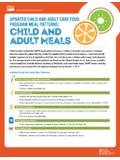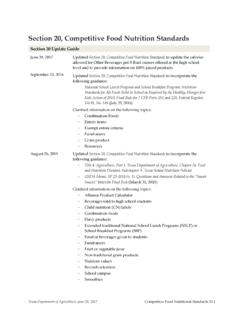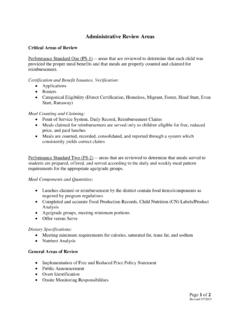Transcription of Farm to School Planning - squaremeals.org
1 farm to School Planning The ready . Set. Go! Approach Together, we can build healthier Texas schools!Texas Department of Agriculture | Commissioner Sid Miller PARENTS CAN HELP GROW farm TO School Parents and family members make a difference for their children and their communities when they support schools bringing more local products into cafeteria meals. This guide provides a blueprint for parents interested in supporting the creation of a robust farm to School program in their child s K-12 setting. Parents also will find connections to resources offering ideas, inspiration and funding for farm to School projects. Most farm to School projects start with small grassroots efforts that can have a larger impact than you realize. Collectively, farm to School activities are shaping young generations, one project at a time.
2 Now, just follow the Texas Department of Agriculture s ready ?, Set!, Go! steps leading to a successful farm to School environment. Texas farm Fresh Initiative Planting the Seeds for Student Achievement while Supporting Texas Farmers and Ranchers We hope that this guide assists you in starting a farm to School project. As you continue to work toward implementing farm to School in multiple ways, do not forget about the resources that are available to help you. Have a successful farm to School project? We would love to hear about it, and we want to share your story with others. Please reach us at Do Your Homework. Gather information and talk to teachers about existing School activities that could transition into farm to School . These could include School gardens, field trips, fundraisers, taste testing or classroom lessons.
3 Use this self-assessment tool created by the Minnesota Department of Health to identify next steps based on current programs. Talk to your School s nutrition team members about the menu Planning process and how they determine what food items to purchase. Ask about current efforts to solicit feedback from students through taste tests, surveys or student advisory groups. Talk to local producers about their interest into selling to schools and encourage them to connect with schools by signing up for the farm Fresh Network at In addition, learn about your School s wellness policy. Every School district receiving federal support for meals is required to have a policy that addresses nutrition education, physical activity and healthy School meals. farm to School may help schools reach their goals for wellness policies and other programs.
4 You may want to determine if teachers are using food as part of their curricula or if the cafeteria encourages students to try new foods and how they do so. Contact your child s Parent Teacher Association (PTA) or district appointed School Health Advisory Council (SHAC) to identify key players inside of the School organization with the necessary motivation to launch farm to School . SHACs are responsible for assisting schools districts in ensuring that local community values are reflected in health education attention to the existing efforts that would be supported by additional farm to School activities. If meeting with the food service director, it may be helpful to learn about the federal meal pattern using resources on TDA s farm to School Web pages. And remember that they are the School nutrition experts.
5 Developing a relationship with your School or district s food service director can be critical to success. He or she will be a key player in continuing to support farm to School efforts. Get Inspired. Visit for resources and success stories. You can also visit the National farm to School Network s resource library to collect information on what others are doing and how they have done it. It s important to consider ideas that fit your motivation and your community s aspirations. Remember that many successful farm to School initiatives were grassroots efforts that started with a just a few motivated parents. The following steps will prompt you to think about how you can connect with your child s School using research, preparation and an assessment. ready Build a Team. Enlisting the support of different School stakeholders makes farm to School more fun and productive.
6 USDA provides some helpful guidance for building a strong farm to School team and ensuring strong collaboration. You can access this resource here. Your team could include: Administrators School board members Community members School coaches Community organizations School food service staff Farmers and producers School organizations Gardening groups School staff members Government agencies Students Parents Teachers Develop an Action Plan. Once you have built a farm to School team, plan a convenient time and place to meet. During the meeting, share your vision for launching a farm to School project and ask the group to share their ideas for implementing farm to School activities. Prioritize suggestions and determine achievable steps. Start with one or two goals and detail exactly how you intend to accomplish each of them.
7 In addition, try to set a long-term, overarching goal or mission for your team. Find Funding. Some farm to School activities have start-up costs, and there are an array of ways to develop funding sources. You may choose to apply for grants. For a list of available grants, visit You may also find funding avenue ideas in the National farm to School Network fact sheet. Your farm to School team can get off to a strong start by hosting a fundraiser. This event could raise money for a School garden or for kitchen equipment that would help facilitate preparation of fresh local foods. Consider asking the School nutrition team about allowable costs built into the School nutrition budget. There are strict parameters if you intend on using funding directly from this nutrition budget source and this USDA memo is a great primer for understanding allowable costs for farm to School activities.
8 Set Make Your Move. You have done your homework, built a team and set a plan. You are ready to start! As you begin, remember that there are several resources available to assist you with your plans. If you encounter setbacks along the way, remember that it is all a part of the process and that reorienting your goals can be the means for long-term success. Plant Seeds with Suggestions. School staff members have educational priorities and strict academic guidelines, so encouraging them to incorporate farm to School in the classroom, garden or field trips must be done with awareness of protocols. Sometimes, parents find that the best time to implement farm to School activities is during lunch or after the School day, when there is less pressure for teachers to make the most of instructional time.
9 If you or a farm to School team member has an opportunity, teachers and administrators can be made aware of resources. There are several free resources for garden-friendly teaching materials available through TDA s farm Fresh Educational Resources Web page. Visit your School s website to see if they offer any volunteer opportunities suitable for assisting with incorporating farm to School in these areas. One easy way to encourage the use of local foods in School meals is to suggest that your School district take part in TDA s Local Products Challenge. Each year, the Local Products Challenge inspires districts to use more Texas products in cafeteria meals and recognizes participants that complete the challenge. It is an annual challenge hosted by TDA that is free to enter. TDA sends support materials and resources to all participating School districts to help communicate about local purchasing activities.
10 Spread the Word. Once you have launched your project, begin spreading the word to others outside of your farm to School team. Keeping your community informed can take several forms. For example, contact local media or launch a section in the School newsletter dedicated to farm to School . Attend town meetings or School board meetings. Host an event or fundraiser to raise awareness about farm to School . Keep Going and Keep Growing. Once you have successfully implemented your first goal or two, revisit your team s goal list and see what you can accomplish next. Now that your farm to School team has already tackled one project together, the next one will be easier to handle. Always remember that it is also important to keep refining and building upon the work you ve started. Go! Texas Department of Agriculture Commissioner Sid Miller This product was funded by USDA.
















